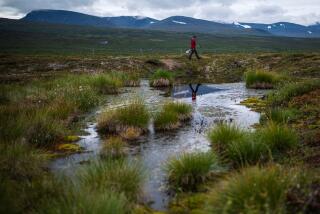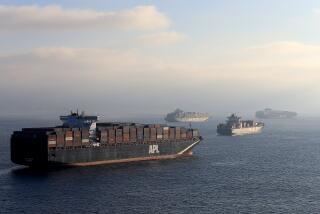Arctic sea ice gaps drive toxic mercury conveyor belt
- Share via
Gaps forming in seasonal Arctic sea ice may be creating a toxic conveyor belt, drawing mercury from higher altitudes to rain down on the ice, snow and tundra, according to a new study.
The gaps, which come as the region shifts from perennial ice to thinner seasonal ice due to climate change, drive convection currents in the lower atmosphere that cycle mercury and ozone from higher levels toward Earth’s surface, where oxidation converts the mercury into a more toxic form, according to the study published online Wednesday in the journal Nature.
“Most atmospheric mercury is in elemental form, but it can be converted to an oxidized form, and this oxidized form is much more reactive, and this will deposit out of the atmosphere very quickly,” said atmospheric scientist Christopher W. Moore of the Desert Research Institute in Reno, lead author of the paper.
“We think that these [events] add hundreds of tons of additional deposition of mercury to Arctic ecosystems each year,” said fellow author Daniel Obrist, of the institute.
The Arctic ecosystem is home to such animal as seals, commercially harvested fish, and the endangered polar bear, which are being increasingly stressed by climate change.
The largely sunlight-driven depletion of ozone and mercury in the lower atmosphere has been a well-chronicled phenomenon. But the nuanced geochemistry of such “depletion events” has not been well understood, nor factored into climate models, researchers said.
The researchers analyzed air samples at Barrow, Alaska, then juxtaposed them with satellite maps of nearby sea ice and a computer-generated chronology of the movement of local air masses. They found that when mercury and ozone levels began to recover after depletion events, the air masses associated with those rises had recently passed over gaps in the sea ice.
Because ozone increased in tandem with the mercury, but is not produced by ice, water or snow, researchers concluded that air circulation was drawing both from higher elevations. At higher elevations, ozone protects Earth from solar radiation, but at lower levels, it is the main component of smog.
The researchers believe two halogen elements - bromine and chlorine - could be driving the chemical cycle associated with depletion events and the oxidation of elemental mercury.
A separate research team in Barrow detected unprecedented levels of chlorine and unusual patterns of chlorine buildup during critical sunlight hours – an indication that it was being steadily supplied from snow and ice, according to a study published Sunday in the journal Nature Geoscience.
The naturally occurring chlorine is broken down by solar radiation into radicals that support the bromine chemical cycle, the dominant factor in the oxidation of mercury, said Georgia Tech atmospheric chemist L. Gregory Huey, an author of the Nature Geoscience study.
While the studies involve mostly naturally occurring elements and molecules – with the exception of pollution-linked mercury - they suggest that climate modeling will have to account for more nuanced processes when calculating the effects of climate change in the Arctic environment, where temperature rise has been more acute than elsewhere on the globe.
“As the climate changes and the amount of sea ice changes, you have physical effects – how much open water there is and how much convection you have, which mixes gases down from above as well as taking gases up,” said Huey. “Things are going to change. And we don’t have a good enough handle on the Arctic chemistry.”
Among the more pressing issues will be what becomes of the deposited mercury, including how much of it is converted to methyl mercury, the form most easily absorbed by vegetation and animals.
“There are many other climate change effects that can and will affect the mercury cycling,” said Obrist. “All of these different aspects of the cycles can be affected in different ways. So, what’s the net effect? That’s a complex answer to get at.”







